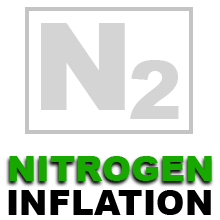 Air typically contains 78% Nitrogen, 21% Oxygen with the remaining 1% made up of carbon dioxide and other trace gases.
Air typically contains 78% Nitrogen, 21% Oxygen with the remaining 1% made up of carbon dioxide and other trace gases.
Improved Fuel Economy
Tests show vehicles using Nitrogen in their tyre use around 2 to 3% less in fuel. Why? The main factor is due to under inflation which creates more friction resulting in increased fuel consumption.
Larger Nitrogen molecules take much longer to migrate through the tyre than oxygen thus tyres filled with Nitrogen will maintain the correct pressure for longer.
Better Tyre Performance
Tyres perform the best at the recommended pressure for the application. Not only does Nitrogen maintain the correct pressure for longer, the exclusion of other gases and water vapour results in more consistent pressure at higher operating temperatures such as high performance vehicles. Most race cars only use Nitrogen in their tyres for this reason.
Longer Tyre Life
As mentioned above, tyres inflated to the correct pressure roll with less friction thus reducing the physical wear on the tyre. Nitrogen also eliminates Oxygen and water vapour from the tyre which can cause corrosion of the rim and oxidation of the tyre casing. This is an important factor in tyres with a long service life such as the transport and mining industries.
Further information:
These benefits impact all vehicles on the road from everyday commuters to the transport industry. Fleet vehicles, particularly trucks for haulage and the logistics industries can make substantial savings in fuel economy, tyre wear & maintenance and increased safety for both their drivers and other road users.
